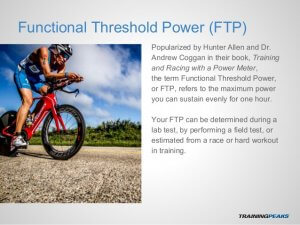 An internet search for “How to take an FTP test” provides a flurry of results. Google and Alexa cannot evaluate this information for you. Which testing protocol should you use? How often should you execute one? Is an FTP test worth the pain and suffering?
An internet search for “How to take an FTP test” provides a flurry of results. Google and Alexa cannot evaluate this information for you. Which testing protocol should you use? How often should you execute one? Is an FTP test worth the pain and suffering?
In this blog entry, we will discuss the information you need to know to best execute an FTP test. Before we get to the nitty-gritty details, it is important to understand the history and purpose of this metric. Once we understand FTP in the proper context, I will outline the testing protocol used by KyleCoaching.
The ABCs of FTP:
What is Functional Threshold Power (FTP)? Exercise physiologists study the effects of blood lactate related to exercise intensity. From this research, we can use blood lactate concentration as a means to determine aerobic training levels. An athlete’s cardiovascular fitness (VO2max) sets the upper limit to their rate of aerobic energy production and Lactate Threshold as a percentage of their VO2max they can utilize at any given point in time. Most endurance sports athletes to use an FTP test to set such zones or levels.
According to Hunter Allen and Andy Coggan, FTP is defined as “the highest power that a rider can maintain in a quasi-steady state without fatiguing for approximately one hour. When power exceeds FTP, fatigue will occur much sooner, whereas power just below FTP can be maintained considerably longer (Allen and Coggan 2010)”.
Over the years, Hunter Allen’s 20-minute FTP test yielded the most success. Also, we prefer TrainingPeaks as our platform to deliver training plans, and they have an automatic threshold change notification built in for the athlete. The formula for Allen’s FTP test is straightforward. Take your hardest 20-minute test effort and subtract 5%. The result is your functional threshold value. For example, suppose your 20-minute effort yielded an average power of 200 watts, your FTP would be 190 watts. Hunter Allen explains in his blog that you subtract the 5% from your average since your actual FTP is the highest average power you can maintain for sixty minutes. (Allen, Hunter Allen Power Blog 2013)
From our perspective, the Coggan Protocol is a reasonable estimate of your hour power and is currently what most coaches recommend, and athletes perform. We describe this test in the following section.
There are other options that we feel should be mentioned as alternatives.
Friel Protocol – 30-minute test – all out effort for 30-minutes and use the average of this as your FTP (Friel 2009)
CTS Protocol – 2 x 8-minute test – where you take the higher number of two back-to-back 8-minute efforts then subtract 10% (Carmichael Training Systems LLC. 2009).
Once you calculate your FTP, you enter this number into your TrainingPeaks zone setting to have it auto calculate based on Threshold Power and Andy Coggan (6) method.
Test? I hate tests. What do I need?
- You will need a power meter and a head unit to display (a) your power and (b) a timer.
- Before you start the test, ZERO your power meter.
- Be forewarned that this is a VERY HARD test.
- The test can be completed indoors on a trainer or outdoors on the road. We have found that most riders get a higher value outdoors. However, this last winter we have seen several athletes that have been able to replicate the outdoor FTP test using Zwift indoors. The choice is yours.
How often should I test?
Initially, we recommend that an athlete take the test and repeat it two times over the next 8-weeks. These tests have a learning curve and new athletes typically pedal too hard at the beginning and fade dramatically toward the end, if they make it that far. The results from the FTP test determine training zones, which should be set at the beginning of a four-week training block. At the end of the training block, we test again. Typically the FTP test at the end of the second block is the one executed to standard.
The COGGAN PROTOCOL
Start with a good warmup. The warmup below is more descriptive than prescriptive. If it takes you a little longer to warm-up, take all the time you need.
The main set is prescriptive. The first 5-minutes is an all-out effort. Remember your Threshold Power is an aerobic activity. By making an all-out effort, it will minimize how much your anaerobic system will contribute to your FTP test. Easy pedal for 5-minutes. When you are ready for the 20-minute effort, hit the lap button and go at it. Do not start off as if it were a sprint, stay in the saddle and go hard. Settle into a rhythm and hold a power that you believe you can do for twenty minutes. At the end of the test, cool down.
Upload your workout to Training Peaks. If you did not have an FTP calculated in the software and notifications are set on, the software will determine your new FTP and email you a sweet little note. You can also go into the workout and select your peak 20-minutes. Take that average power number and multiply it by 95%. This will give you your FTP. Add this number to your TrainingPeaks setting and calculate Threshold Power, Andy Coggan (6) method and this will set your training zones.
The workout shown below is an actual FTP test.
| FTP Test | Initial Test | Follow on Tests | ||
| Activity | Time | Description | Perceived Exertion (1-10) | % of FTP |
| Warm-up | 20 min | Easy riding | 4 | <65 |
| 3 x 1 min (1 Min RBI) |
Fast pedaling, 100+ RPM |
4 | <50 | |
| 5 min | Easy Riding | 4 | <65 | |
| Main Set | 5 min | All-out | 10 | Max |
| 10 min | Easy riding | 5 | <65 | |
| 20 | FTP Test | 10 | Max | |
| Cool down | 15 min | Easy riding | 5 | 60 |
Should I do this every four weeks?
In general, assessing threshold power a few times per year (e.g., near the start of training as a baseline, partway through the pre-competition period to track improvement, and during the season to determine peak fitness achieved) is probably sufficient.
References
Allen, Hunter. Hunter Allen Power Blog. January 9, 2013. http://www.hunterallenpowerblog.com/2013/01/what-is-ftp.html (accessed May 6, 2018).
Allen, Hunter, and Andrew Coggan. Training and Racing with a Power Meter. Boulder: Velopress, 2010.
Carmichael Training Systems LLC. CTS. 2009. https://trainright.com/cts-field-test-instructions-training-intensity-calculations/ (accessed May 6, 2018).
Friel, Joe. Joe Friel’s Blog. November 26, 2009. http://www.trainingbible.com/joesblog/2009/11/quick-guide-to-setting-zones.html (accessed May 6, 2018).


